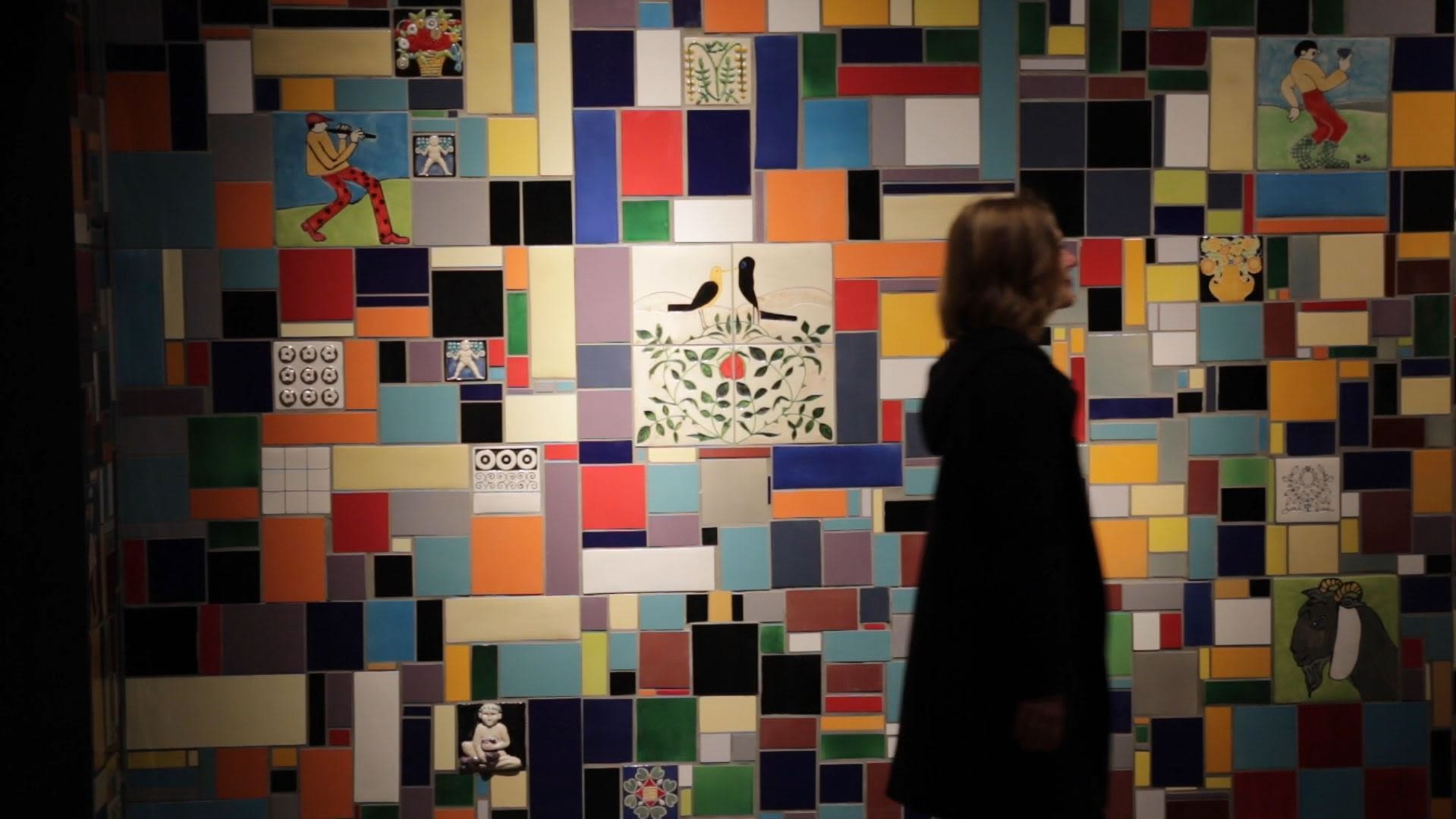Rebuilding Vienna's Cabaret Fledermaus
From a black and white photograph to a life-size recreation in our gallery, we explore the story behind Cabaret Fledermaus and how we brought it back to life in Into the Night: Cabarets and Clubs in Modern Art.

While you're reading...
Listen to a selection of music from the clubs and cabarets we explore in Into the Night: Clubs and Cabarets in Modern Art.
In October 1907, on the corner of Kärntner Straße 33 and Johannesgasse 1 in Vienna, a new kind of club emerged in a converted basement of a residential building. Cabaret Fledermaus was conceived as a place where the ‘boredom’ of contemporary life would be replaced by ‘ease, art and culture’.
It was created by the Wiener Werkstätte (Vienna Workshop), a group of artists and designers founded by architect Josef Hoffmann, artist Koloman Moser and businessman Fritz Waerndorfer. Their aim was to stimulate the senses through a synthesis of modern architecture, painting, poetry, music and dance creating a space where ‘none of the arts were excluded’ and craftsmanship was championed.

Visiting Cabaret Fledermaus
An illuminated sign on the corner of the street, designed by Bertold Löffler, directed visitors to the entrance of the club. Descending a dramatically striped black and white marble staircase, visitors found themselves in a spectacular bar space, lined with over 7,000 tiles depicting fantastical motifs.
Josef Hoffmann had commissioned Löffler and Michael Powolny, co-founders of the Wiener Keramik workshop, to create the tiles; their collaborative work resulted in an exuberant explosion of colour on every wall. The bar led to the auditorium, whose elegant design was relatively minimal by comparison. The rounded, whitewashed room featured a simple, traditional stage and a mezzanine level with boxes for the audience.

Together, the Wiener Werkstätte converted the unassuming basement into a dazzlingly elegant space, manifesting the decorative aesthetic of the Vienna Secession and the sensuality of the emerging Expressionism movement. Meticulous attention was paid to everything from the cutlery and ashtrays to the stationery and pins for the waiting staff to wear, which featured the cabaret’s logo of a woman smelling a flower incorporated into the monogram ‘KF’. The design of the Cabaret Fledermaus manifested the influence of the decorative aesthetics of the Vienna Secession, a group of artists (including Hoffmann) who sought to move away from academic tradition while also exploring the sensuous ideals of emerging Expressionism.
Live performance was at the cabaret’s heart: it hosted short satirical plays, evocative shadow theatre, avant-garde dance, poetry readings and musical performances ranging in tone from humour to decadence. In particular, the stage offered a platform for epoch-defining female performers such as Grete Wiesenthal and Marya Delvard, supported by extravagant sets and elaborate costume designs.

Reconstructing Cabaret Fledermaus
Cabaret Fledermaus closed its doors in 1913 due to financial difficulties and there are only a few records that remain of what this dazzling club space would have looked like. There are three surviving photographs, postcards by the Wiener Werkstätte and floorplan and elevation sketches by Le Corbusier from 1907, when he was in close contact with Hoffmann while staying in Vienna.
With so few visual resources to work with, bringing Cabaret Fledermaus back to life in our gallery space for Into the Night was always going to be a challenge. We spoke to the team from the University of Applied Arts Vienna to learn more about how they brought the vibrant Cabaret Fledermaus from postcard to reality.
You were given a black-and-white photo and a colour illustration - can you describe the design process of bringing Cabaret Fledermaus to life from a single photograph?
The photograph shows fifty-six decorative tiles with a number of different designs and techniques - as relief, engraved, and painted. However, it is not always clear from the photo how the tiles were designed. As part of our research, the Bertold Löffler expert Gerd Pichler was asked to analyse the ceramic decor of the tile mosaic. He identified motifs in the photo whose form and colour corresponded to other Wiener Keramik objects, such as those shown in sample books of the Wiener Werkstätte, which took over distribution of Wiener Keramik products in 1907.
Revisiting Löffler’s estate in the Collection and Archive of the University of Applied Arts Vienna led to the discovery of sketches that could be attributed to individual tile motifs of the Cabaret Fledermaus. Nine of the fifty-six designs on the counter and the two walls visible in the photograph could be identified on the basis of samples or sketches. A stylistic context could be established for about thirty designs.

Sketches of Cabaret Fledermaus tiles by Bertold Löffler. Courtesy of University of Applied Arts Vienna, Collection and Archive
Sketches of Cabaret Fledermaus tiles by Bertold Löffler. Courtesy of University of Applied Arts Vienna, Collection and Archive
The colours of the tiles were difficult to establish from the black-and-white photograph. However, based on the archive materials we were able to approximate some of the colours. A survey of contemporary documents from the University archives detailing glaze techniques and the composition of ceramic glazes at around 1906 yielded further insights. Furthermore, a comparison with Wiener Keramik objects from the years 1905 to 1908 held in the Collection and Archive gave us an exact template for the colours dark green, yellow, and dark blue.
The ceramists Maria Wiala (University of Applied Arts Vienna) and Beate Seckauer (Neuzeughammer Keramik) made production sketches based on the information we had. Beate Seckauer then designed prototypes from which moulds were made, and produced the main part of the designs shown in the recreation, while Maria Wiala led a workshop at the University, where students recreated some of the tiles seen in the counter mosaic.
What was the process behind creating the tiles?
To realize the project, the Research Institute Collection and Archive of the University of Applied Arts Vienna worked together with two tile companies, Spadlinek und Fliesenmacher and Neuzeughammer Keramik, as well as with the Ceramics Studio of the Institute of Art & Technology at the University of Applied Arts Vienna and the School of Ceramics in Stoob.

Different tiles before burning. Photo: Beate Seckauer
Different tiles before burning. Photo: Beate Seckauer
An important step was to define the laying pattern as well as the sizes of the tiles. Thanks to previous research, the sizes of some of the tiles were already known. From this, we were able to produce a scale drawing showing the dimensions of the remaining tiles and the laying pattern. Since we had no information about the rest of the room, we decided to use the same pattern for the arrangement of the tiles on the ‘unknown’ remaining walls.
Based on the space available for the recreation at the Barbican Art Gallery, the designer Robert Müller, working in collaboration with Sofie Mathoi and Caruso Architects, developed a design that divides each wall into ninety-eight panels on which the tiles were laid in accordance with the photograph.

Wiener Werkstätte Postkarte No. 74 (Interior view of the bar at the Cabaret Fledermaus), 1907, Collection of Leonard A. Lauder
Wiener Werkstätte Postkarte No. 74 (Interior view of the bar at the Cabaret Fledermaus), 1907, Collection of Leonard A. Lauder
Watch a timelapse of the construction of Cabaret Fledermaus by University of Applied Arts Vienna
Watch a timelapse of the construction of Cabaret Fledermaus by University of Applied Arts Vienna
Can you share any information about the historical significance of any of the designs on the tiles?
As early as 1905–1911, the Wiener Keramik Löffler/Powolny created a room of colorful Majolica tiles for Palais Stoclet in Brussel, one of the Wiener Werkstätte‘s most prestigious projects. The tiles, designed for use in a children’s bedroom, featured images of cherubs with flutes and drums.
The Cabaret Fledermaus was Löffler and Powolny’s most comprehensive and elaborate tile project. Motifs range from standard Wiener Keramik designs - i.e. already existing motifs - to quirky new creations. These include demonic eyes, an abstract depiction of a monkey, and a caricature by Peter Altenberg, all of which are only known from this particular project. The ‘Amor venator’, on the other hand, which in the 1980s had been attributed to the Cabaret Fledermaus, is now thought to belong to the repertoire of the Salzburger Volkskeller - according to new research carried out by Gerd Pichler in his doctoral thesis, Bertold Löffler: Life and Work (Vienna, 2017, S. 43). In 1909, the renowned Vienna art critic Ludwig Hevesi described the colourful walls as an ‘ingenious feat of decorative imagination’.
‘One thousand of these tiles are decorated; with images, drawings, vignettes, symbols, caricatures, Modernist tomfooleries, portraits, sketches, humor, in short, with all manner of figurative jollities. Much of it is three-dimensional: relief and engraving…’
The style of the tile designs can be traced back to the unique visual vocabulary of Löffler and Powolny respectively. Bertold Löffler, who had been raised and educated by Koloman Moser, combined ‘sophisticated primitivism and decorative mannerism’ (Gabriele Koller) in his planar designs. Bertold Löffler, meanwhile, used different style variants alongside each other, ranging from geometric purism, Neoclassicism, Modernism, Neo-Biedermeier, and folk art elements.
(see Bertold Löffler: Vagant zwischen Secessionismus und Neobiedermeier, ed. Erika Patka, 2000)
Into the Night: Cabarets and Clubs in Modern Art
4 Oct 2019–19 Jan 2020
A journey into the world’s most iconic cabarets, cafés and clubs in modern art through the lens of pioneering artists.
This landmark exhibition explores the history of cabarets, cafés and clubs in modern art across the world, from London to New York, Paris, Mexico City, Berlin, Vienna, and Ibadan. Discover works of art, many rarely seen in the UK, as well as life-size recreations of avant-garde spaces.
Watch the Into the Night exhibition trailer:
Into the Night: Cabarets & Clubs in Modern Art catalogue is available to purchase in the Barbican Art Gallery shop and online.

